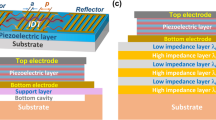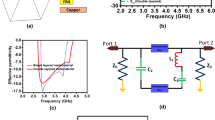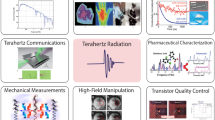Abstract
The epsilon negative materials are found to have applications in the sensor development and microwave device integration for their performance enhancement. However, their existence for S-band operation suffers from relatively large size, the characterization with the bigger dimensions waveguide or horn, and improper permeability (μ < 0) at few spectral frequencies. In this paper, a compact unit-cell design of the complementary square patch loaded artificial material is presented which exhibits a perfect epsilon negative response with μ > 0 in the microwave S-band. The numerical analysis was validated by fabricating the unit-cell structure on a Rogers isotropic thermoset microwave material of relative permittivity ɛr = 12.85 and measuring its scattering parameters spectra using 50 Ω subminiature version-A elongated probe tapping and coupling method. The measured resonance of the transmission and reflection magnitude at 2.64 GHz and 2.85 GHz show a close matching with the simulated results. The material medium parameters of the unit-cell were calculated and verified. The applicability of the proposed epsilon negative unit-cell is shown by loading it in a two-port 50 Ω microstrip line, which then excites a stop-band resonance and yet maintains a low-profile. Therefore, such an artificial material may be used to facilitate miniaturization in the microwave circuit devices.












Similar content being viewed by others
References
Rotaru, M., Ying, L. Y., Kuruveettil, H., et al. (2008). Implementation of packaged integrated antenna with embedded front end for bluetooth applications. IEEE Transactions on Advanced Packaging, 31(3), 558–567.
Haddadi, K., Bakli, H., & Lasri, T. (2012). Microwave liquid sensing based on interferometry and microscopy techniques. IEEE Microwave and Wireless Components Letters, 22(10), 542–544.
Yadav, R., & Patel, P. N. (2016). Experimental study of adulteration detection in fish oil using novel PDMS cavity bonded EBG inspired patch sensor. IEEE Sensors Journal, 16(11), 4354–4361.
Ting, W., Xiao-Wei, S., Ping, L., et al. (2013). Tri-band microstrip-fed monopole antenna with dual-polarisation characteristics for WLAN and WiMAX applications. Electronics Letters, 49(25), 1597–1598.
Wang, Y., & Du, Z. (2014). A printed dual-antenna system operating in the GSM1800/GSM1900/UMTS/LTE2300/LTE2500/2.4-GHz WLAN bands for mobile terminals. IEEE Antennas and Wireless Propagation Letters, 13, 233–236.
Jiang, Z. H., Gregory, M. D., & Werner, D. H. (2016). Design and experimental investigation of a compact circularly polarized integrated filtering antenna for wearable biotelemetric devices. IEEE Transactions on Biomedical Circuits and Systems, 10(2), 328–338.
Ahsan, M. R., Islam, M. T., & Ullah, M. H. (2015). A new biopolymer substrate-based compact monopole antenna covering RFID, WiMAX, and C/X-band. Microwave and Optical Technology Letters, 57(9), 2002–2005.
Prasath, S. D., Balaji, S., Raju, S., Abhaikumar, V., et al. (2016). Synthesis and characterization of zinc substituted nickel ferrite materials for L band antenna applications. Journal of Materials Science: Materials in Electronics, 27(8), 8247–8253.
Liu, Y., Wang, H., Li, K., et al. (2015). RCS reduction of a patch array antenna based on microstrip resonators. IEEE Antennas and Wireless Propagation Letters, 14, 4–7.
Zakharov, A. V., & Rozenko, S. A. (2012). Duplexer designed on the basis of microstrip filters using high dielectric constant substrates. Journal of Communications Technology and Electronics, 57(6), 649–655.
Yamasaki, N. Y., Sekiya, N., Kikuchi, T., et al. (2015). Dielectric resonators as radiation detectors at low temperatures. Journal of Low Temperature Physics, 181(1), 59–67.
Moghadasi, S. M., Attari, A. R., & Mirsalehi, M. M. (2008). Compact and wideband 1-d mushroom-like ebg filters. Progress in Electromagnetics Research, 83, 323–333.
Gupta, A., & Chaudhary, R. K. (2016). A compact planar metamaterial triple-band antenna with complementary closed-ring resonator. Wireless Personal Communications, 88(2), 203–210.
Dong, Y., Toyao, H., & Itoh, T. (2011). Compact circularly-polarized patch antenna loaded with metamaterial structures. IEEE Transactions on Antennas and Propagation, 59(11), 4329–4333.
Palandöken, M., & Uçar, M. H. B. (2014). Compact metamaterial-inspired band-pass filter. Microwave and Optical Technology Letters, 56(12), 2903–2907.
Smith, D. R., Padilla, W. J., Vier, D. C., et al. (2000). Composite medium with simultaneously negative permeability and permittivity. Physical Review Letters, 84(18), 4184–4187.
Smith, D. R., Pendry, J. B., & Wiltshire, M. C. K. (2004). Metamaterials and negative refractive index. Science, 305(5685), 788–792.
Gao, X.-J., Cai, T., & Zhu, L. (2016). Enhancement of gain and directivity for microstrip antenna using negative permeability metamaterial. AEU—International Journal of Electronics and Communications, 70(7), 880–885.
Jiang, Z. H., Gregory, M. D., & Werner, D. H. (2011). A broadband monopole antenna enabled by an ultrathin anisotropic metamaterial coating. IEEE Antennas and Wireless Propagation Letters, 10, 1543–1546.
Unal, E., Dincer, F., Tetik, E., et al. (2015). Tunable perfect metamaterial absorber design using the golden ratio and energy harvesting and sensor applications. Journal of Materials Science: Materials in Electronics, 26(12), 9735–9740.
Lin, X. Q., Jin, J. Y., Jiang, Y., et al. (2013). Metamaterial-inspired waveguide filters with compact size and sharp skirt selectivity. Journal of Electromagnetic Waves and Applications, 27(2), 224–232.
Oraizi, H., & Torabi, S. Y. (2013). Novel application of a new metamaterial complementary electric LC resonator for the design of miniaturized sharp band-pass filters. International Journal of RF and Microwave Computer-Aided Engineering, 23(4), 471–475.
Torabi, Y., Dadashzadeh, G., & Oraizi, H. (2016). Miniaturized sharp band-pass filter based on complementary electric-LC resonator. Applied Physics A, 122(4), 273.
Antoniades, M. A., & Eleftheriades, G. V. (2012). Multiband compact printed dipole antennas using NRI-TL metamaterial loading. IEEE Transactions on Antennas and Propagation, 60(12), 5613–5626.
Veselago, V. G. (1968). The electrodynamics of substances with simultaneously negative values of permittivity and permeability. Soviet Physics Uspekhi, 10(4), 509–514.
Shelby, R. A., Smith, D. R., & Schultz, S. (2001). Experimental verification of a negative index of refraction. Science, 292(5514), 77–79.
Pendry, J. B., Schurig, D., & Smith, D. R. (2006). Controlling electromagnetic fields. Science, 312(5781), 1780–1782.
Wang, R., Wang, B.-Z., Gong, Z.-S., et al. (2015). Far-field subwavelength imaging with near-field resonant metalens scanning at microwave frequencies. Scientific Reports, 5, 11131.
Aznar, F., Gil, M., Bonache, J., et al. (2008). Modelling metamaterial transmission lines: A review and recent developments. Opto-Electronics Review, 16(3), 226–236.
Durán-Sindreu, M., Naqui, J., Bonache, J., et al. (2012). Split rings for metamaterial and microwave circuit design: A review of recent developments (Invited paper). International Journal of RF and Microwave Computer-Aided Engineering, 22(4), 439–458.
Falcone, F., Lopetegi, T., Baena, J. D., et al. (2004). Effective negative-/spl epsiv/stopband microstrip lines based on complementary split ring resonators. IEEE Microwave and Wireless Components Letters, 14(6), 280–282.
Luo, X., Qian, H., Ma, J., et al. (2010). Wideband bandpass filter with excellent selectivity using new CSRR-based resonator. Electronics Letters, 46(20), 1390–1391.
Duran-Sindreu, M., Velez, P., Bonache, J., et al. (2011). Broadband microwave filters based on open split ring resonators (OSRRs) and open complementary split ring resonators (OCSRRs): Improved models and design optimization. Radioengineering, 20(4), 775–783.
Ebrahimi, A., Withayachumnankul, W., Al-Sarawi, S. F., et al. (2014). Dual-mode behavior of the complementary electric-LC resonators loaded on transmission line: Analysis and applications. Journal of Applied Physics, 116(8), 083705.
Naqui, J., Durán-Sindreu, M., & Martín, F. (2013). Differential and single-ended microstrip lines loaded with slotted magnetic-LC resonators. International Journal of Antennas and Propagation, 2–13, 1–8.
Machac, J., Rytir, M., Protiva, P., et al. (2008). A double H-shaped resonator for an isotropic ENG metamaterial. In 38th European microwave conference EuMC 2008 (pp. 1–4).
Yurduseven, O., Yilmaz, A. E., & Turhan-Sayan, G. (2011). Triangular-shaped single-loop resonator: A triple-band metamaterial with MNG and ENG regions in S/C bands. IEEE Antennas and Wireless Propagation Letters, 10, 701–704.
Muzeeb, S., Rajesh, G. S., & Kumar, V. (2016). Design of a qudruple band printed monopole antenna using ENG metamaterial antenna. In 2016 IEEE international conference on recent trends in electronics, information & communication technology (RTEICT) (pp. 2144–2148).
Booket, M. R., Jafargholi, A., Kamyab, M., et al. (2012). Compact multi-band printed dipole antenna loaded with single-cell metamaterial. IET Microwaves, Antennas and Propagation, 6(1), 17–23.
Ferdous, S., Hossain, A., Chowdhury, S. M. H., et al. (2013). Reduced and conventional size multi-band circular patch antennas loaded with metamaterials. IET Microwaves, Antennas and Propagation, 7(9), 768–776.
Hossain, M. A., Ferdous, M. S., Chowdhury, S. M. H., et al. (2014). Novel dual band microstrip circular patch antennas loaded with ENG and MNG metamaterials. International Journal of Antennas and Propagation, 2014, 9.
Islam, S. S., Rashed Iqbal Faruque, M., & Tariqul Islam, M. (2016). An ENG metamaterial based wideband electromagnetic cloak. Microwave and Optical Technology Letters, 58(10), 2522–2525.
Kumari, R., & Patel, P. N. (2016). A low-cost dielectric spectroscopic system using metamaterial open horn-ring resonator-inspired BSF and detection circuitry. Applied Physics A, 122(7), 711.
Schneider, M. V. (1969). Microstrip lines for microwave integrated circuits. Bell System Technical Journal, 48(5), 1421–1444.
Gupta, K. C., Garge, R., Bahl, I., & Bhartis, P. (1996). Microstrip lines and slotlines (2nd ed., pp. 1–560). Boston: Artech House.
Wadell, B. C. (1991). Transmission line design handbook (pp. 196–200). Boston: Artech House.
Chen, H., Zhang, J., Bai, Y., et al. (2006). Experimental retrieval of the effective parameters of metamaterials based on a waveguide method. Optics Express, 14(26), 12944–12949.
Hasar, U. C., Barroso, J. J., & Ertugrul, M. (2012). Permeability measurement of split-ringresonator metamaterials from free-space transmission-only calibration-independent methods. Journal of Electromagnetic Waves and Applications, 26(1), 54–63.
Wagner, N., Schwing, M., & Scheuermann, A. (2014). Numerical 3-D FEM and experimental analysis of the open-ended coaxial line technique for microwave dielectric spectroscopy on soil. IEEE Transactions on Geoscience and Remote Sensing, 52(2), 880–893.
Marsland, T. P., & Evans, S. (1987). Dielectric measurements with an open-ended coaxial probe. IEE Proceedings H—Microwaves, Antennas and Propagation, 134(4), 341–349.
Szabo, Z., Park, G. H., Hedge, R., et al. (2010). A unique extraction of metamaterial parameters based on Kramers–Kronig relationship. IEEE Transactions on Microwave Theory and Techniques, 58(10), 2646–2653.
Acknowledgements
The authors thank to the Electronics Engineering Department, Sardar Vallabhbhai National Institute of Technology, for providing the measurement facility. They also thank Rogers Corporation, USA, for providing the free sample (TMM-13i). A special thanks to the Technical Quality Education Program, Phase-II (TEQIP-II), SVNIT-Surat, Department of Science and Technology (DST), Ministry of Human Resource and Development (MHRD), India, and Ministry of Electronics and Information Technology, Government of India which is being implemented by Digital India Corporation (formerly Media Lab Asia) for supporting this research work.
Author information
Authors and Affiliations
Corresponding author
Additional information
Publisher's Note
Springer Nature remains neutral with regard to jurisdictional claims in published maps and institutional affiliations.
Rights and permissions
About this article
Cite this article
Kumari, R., Yadav, R. & Patel, P.N. A Complementary Patch Loaded Epsilon Negative Artificial Material to Facilitate Miniaturization of S-Band Microwave Devices. Wireless Pers Commun 107, 923–938 (2019). https://doi.org/10.1007/s11277-019-06309-x
Published:
Issue Date:
DOI: https://doi.org/10.1007/s11277-019-06309-x




